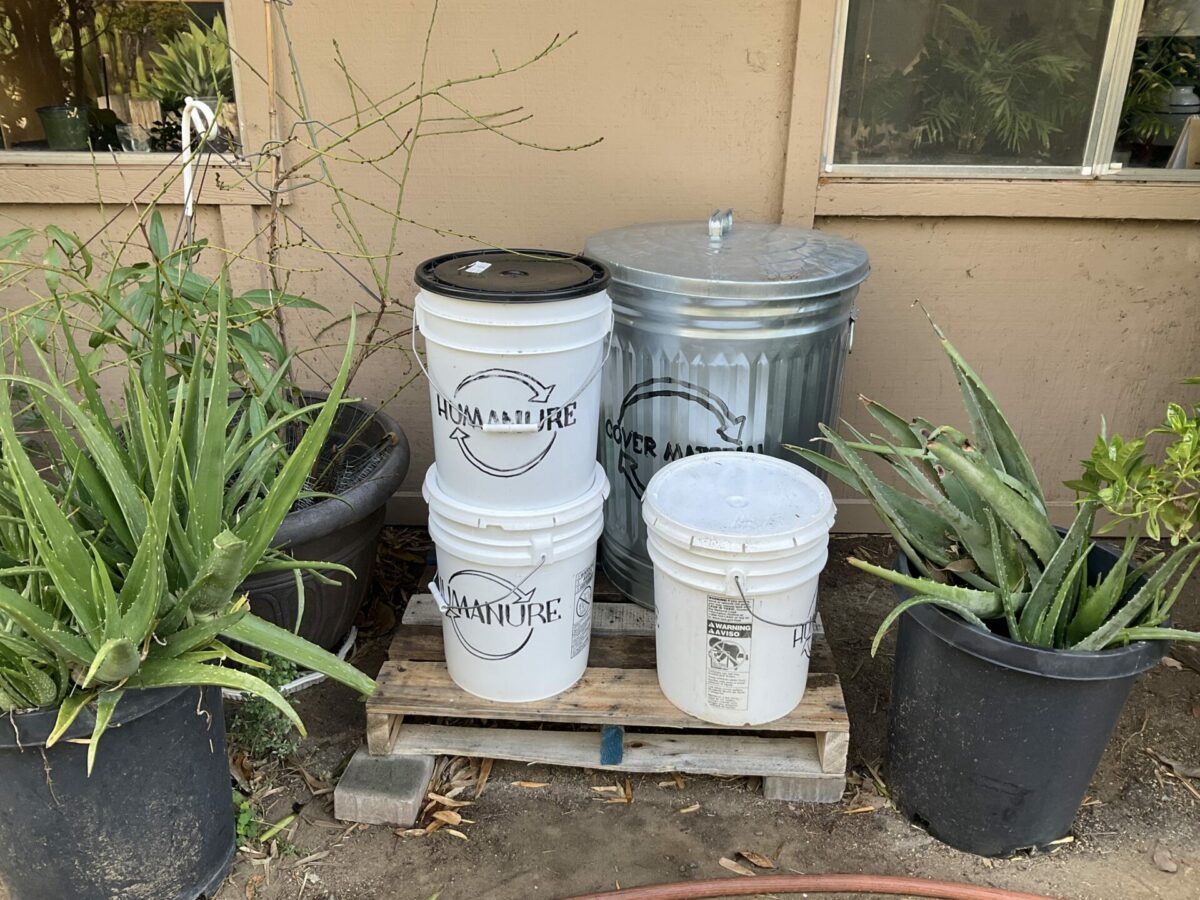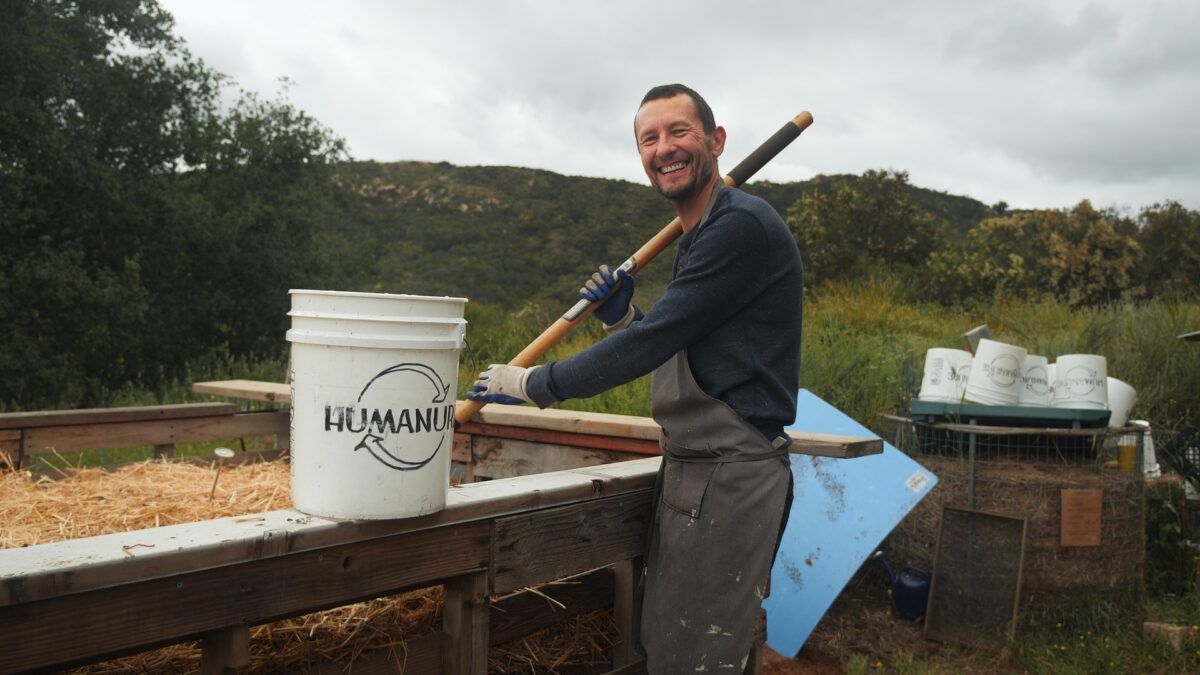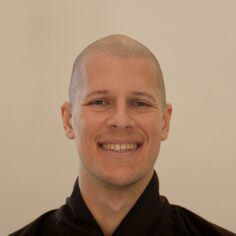By Brother Minh Lượng on
Humanure composting efforts at Deer Park Monastery, helmed by facility manager Nikolay Amirov
At the back of Deer Park Monastery’s dusty soccer field, next to the trailhead that leads down into the valley, sits a big pile of straw, fenced into a square shape by walls of wooden pallets. Nikolay, Deer Park’s facility manager of three years,
By Brother Minh Lượng on
Humanure composting efforts at Deer Park Monastery, helmed by facility manager Nikolay Amirov
At the back of Deer Park Monastery’s dusty soccer field, next to the trailhead that leads down into the valley, sits a big pile of straw, fenced into a square shape by walls of wooden pallets. Nikolay, Deer Park’s facility manager of three years, wears an apron over his flannel shirt as he busily arranges rows of empty white buckets beside the pile. A friend approaches him.

“I noticed these buckets over here,” he says, pointing to the rows. “They say ‘HUMANURE.’ What’s that all about?”
Nikolay replies with a smile, “That’s the recycling of human refuse!”
“Yeah? How does that work?”
“Well, just like composting,” he explains, “You collect it, put it in a pile, and the pile heats up. You can see right now, even though I’ve just added new material, steam is still coming out. Before I opened it, the pile was at 145 degrees Fahrenheit.”
When Nikolay first started working at Deer Park, he had no experience or particular interest in compost. Asked about his relationship to climate change, he reflects, “Climate change was always a concern of mine, but I couldn’t deal with the depth of it. It resulted in an ignorant approach, you know, sometimes it’s just better not to think about [it].” For many years, Nikolay chose not to pay much attention to climate change and environmental concerns. But when his Deer Park workshop started producing excess sawdust, an excellent layering material for compost, he saw a new opportunity for action.
Initially, Nikolay’s composting efforts didn’t work so well. He took a trip to the library, looking for guidance, and found The Humanure Handbook by Joseph Jenkins. Nikolay was taken by the book’s down-to-Earth language and the impressive scientific evidence backing up the humanure system. “Twenty-five percent of my way into the book, I said to myself, ‘I am going to do this. I just need to get the details of how to do it,’” he explains.
When we start to learn about a problem, it’s easy to fall into despair if we don’t see a solution. But when we find a solution and put it into practice, we have hope. We are no longer afraid of despair, and our mind opens up to receive the problem in all its ugly detail.
How to compost human waste, it turns out, is rather simple. First, Nikolay built a handful of composting toilets at Deer Park. These toilets consist of two receptacles: one for deposits and one containing sawdust to scoop out and layer on top of each deposit. Sawdust is an excellent biofilter, removing odors from the deposits beneath it while providing carbon needed for the compost to “cook” later on. Humanure relies on four main ingredients to break down organic matter: carbon, water, air, and nitrogen (found in urine). Without enough air, the composting toilet sits waiting for the final condition to begin its transformation.1
Once a week, Nikolay collects the buckets (or “receptacles,” as he likes to call them) and empties them into his pile behind the soccer field. He uses a pitchfork to pull the straw to the edges and make space in the middle to dump the new material. Afterwards, he cleans the receptacles with a toilet brush and soapy water, which in turn gets emptied into the pile. Finally, he covers it all again with a new layer of straw. Blanketed by straw above, below, and around, the pile is penetrated by air from outside and begins to heat up. Once the temperature reaches 115 degrees Fahrenheit, a special kind of bacteria, called “thermophilic bacteria,” are activated. These powerful bacteria are the main driver of the organic matter’s transformation.

As he implemented the humanure system, Nikolay enjoyed learning about its benefits. The composting process eliminates the greenhouse gasses emitted by standard sewage systems that use energy-intensive treatment techniques. The thermophilic bacteria in the pile break down toxic chemicals, pathogens, and even pharmaceutical drugs, all of which would otherwise create pollution, as they are not broken down by the traditional septic system.
There are also benefits on the local level at Deer Park. Transforming excrement through humanuring diverts it from the monastery’s existing septic system, which expels excess liquid via underground leach fields and can thereby pollute the groundwater. Humanure, on the other hand, produces organic fertilizer, which adds nutrients to the soil and improves water retention, protecting and nourishing plants and, by extension, the whole web of natural life at Deer Park. Recognizing composting as a means to protect life, Nikolay sees in it a concrete expression of the First Mindfulness Training. “At the beginning of The Five Mindfulness Trainings, we are invited to look for ways to protect the lives of animals, plants, and minerals, and that invitation was always very serious to me,” he explains. Thanks to the practice of humanure, Nikolay has a concrete way to act on that invitation.
Humanure is a new development at Deer Park, but the monastery is no stranger to green initiatives. In the late 2000s, there was a wave of enthusiasm among the monks for new projects to support the environment. Thầy had long wished for the brothers to install solar panels, and at that time the conditions came together to do so. “Thầy was very happy,” remembers Thầy Pháp Dung. “Afterwards, he kept mentioning it. He would say how the brothers in Solidity Hamlet are on 100 percent solar energy, even though we were not completely off-grid.”
Aware of droughts afflicting the state of California, the monastics also looked for ways to conserve water. Waterless urinals were installed, native plants began to replace thirsty, tropical varieties, and the cooking teams tried reusing the water for rinsing vegetables to do the dishes afterwards. Thầy Pháp Dung points out that a lot of water goes into our clothes and other possessions as well. He tries to use things as long as he can. “Everything has water in it. So when you throw something away, you’re not just making trash, but you’re throwing away a lot of water.”
Nikolay sees another reason to save water: “Did you know,” he asks me, “Thirty percent of the electricity California consumes is used to move water for us? Thirty percent of our electricity, just to pump water from one place to another; we’re pumping a lot over very long distances. So our Californian water is very carbon heavy.”
Humanure composting fits well into Deer Park’s long-standing effort to conserve water. The practice saves water that would otherwise be used to flush the toilet. Nikolay calculated that the humanure pile processed 547 gallons of matter in a recent three-month period—an approximate water savings of 15,300 gallons! That’s equivalent to an average American’s water use for six months.2 And this is only the beginning. So far, humanure has been adopted to a limited extent at the monastery. Only residents curious and eager to try the new system are using it. With greater adoption in the future, water savings could multiply.
Recently, Nikolay started learning more about climate change. He recounts, “About a month ago, all of a sudden my curiosity awakened, and I felt I have the capacity now to really fill my consciousness with information.” It’s no coincidence that Nikolay’s new enthusiasm to learn and engage with climate change coincided with his new project. When we start to learn about a problem, it’s easy to fall into despair if we don’t see a solution. But when we find a solution and put it into practice, we have hope. We are no longer afraid of despair, and our mind opens up to receive the problem in all its ugly detail. As Nikolay learns about climate change, he remembers how humanuring contributes to its solution, and rather than falling into despair, he feels encouraged and inspired.
There are so many ways to act, but for Nikolay, humanure composting is about doing something small and simple. He describes his joy at seeing that, although so much energy, time, and money are spent building and maintaining the world’s septic systems. “We can do something so humble—just a receptacle, sawdust, a couple steps to the pile, and then in a year and a half this pile is wonderful nutriment for soil. I am very happy I discovered it,” he beams. Compost nourishes the soil, but it also nourishes the one who makes it.
1 Joseph Jenkins, The Humanure Handbook: A Guide to Composting Human Manure, (Vermont: Chelsea Green Publishing, 2005)
2 United States Environmental Protection Agency, 2023, “Statistics and Facts,” Accessed July 11. https://www.epa.gov/watersense/statistics-and-facts


